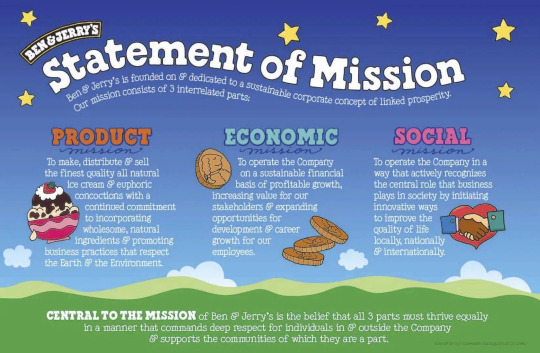#SocialImpactDesign
Explore tagged Tumblr posts
Text
27/AUG/2024
WEEK 3: REFLECTIVE WRITING
Designers should connect their work to society because design can have a meaningful impact on the world. By addressing social issues, designers create work that not only resonates with people but also contributes to positive change and supports important causes. This approach goes beyond aesthetics and profit, focusing on raising awareness and tackling bigger issues like fairness and environmental sustainability.

For example, brands like Ben & Jerry's demonstrate how businesses can integrate social values into their practices, such as using fair trade ingredients and promoting sustainability.

Ben & Jerry's leads in ESG practices by prioritising fairness in sourcing. They use fair trade to buy key ingredients like cocoa, sugar, and bananas from small farms in developing countries, supporting 200,000 farmers annually. Their packaging reflects Vermont’s natural beauty and features a fair trade certification.
In our class, we were tasked with creating a documentary about a social issue. We decided to focus on the high cost of living in Singapore. In our video, an agency shows students a small, messy room with an outrageously high rent. The students, after checking their wallets, find only a handful of coins.
While working on this project, I realised that as designers, we should engage with societal issues like this more often. If designers express such problems through their work, it could help raise awareness and ultimately contribute to changing the world for the better.
230 words
References:
0 notes
Photo

Now, at Rajamangla University of Technology, Thanyaburi another lecture on Social Impact Design #socialimpactdesign #socialarchitecture #mudbricks #communityarchitecture (at Rajamangala University of Thechnology Thanyaburi) https://www.instagram.com/p/B4T_oS3pIpG/?igshid=1auqc40dpmh0i
0 notes
Photo

Two days left!💃💃 #aceforum #acceleratingrevolution #circulareconomycities #circularbusiness #smartcity #sharingeconomy #blockchain #freelance #innovativethinking #thinkdifferently #socialimpactdesign #designsolutions #biomimicry #naijablog (at Ibadan, Nigeria) https://www.instagram.com/p/BqMje-Xlw3d/?utm_source=ig_tumblr_share&igshid=nk1ei5s8wmcc
#aceforum#acceleratingrevolution#circulareconomycities#circularbusiness#smartcity#sharingeconomy#blockchain#freelance#innovativethinking#thinkdifferently#socialimpactdesign#designsolutions#biomimicry#naijablog
0 notes
Photo



(via Refugees are learning to map their world and gain marketable skills in the process | Design Indaba)
The RefuGIS programme helps Syrian refugees tackle the challenges of life in the world’s largest refugee camp.
By Lindsay Samson
Located in Jordan, the Zaatari refugee camp has hosted people fleeing the violence of Syria’s ongoing Civil War since 2012. Estimated to be home to more than 80 000 Syrian refugees, it is one of the world’s largest in terms of population. But managing the growth, infrastructure, allocation of resources and safety of a community of this size has proven challenging; devoid of adequate geographic information systems (GIS), the camp’s layout has long been unmapped, making its problems near impossible to address.
To tackle these challenges and build the GIS services needed, Rochester Institute of Technology’s Brian Tomaszewski, alongside the UN Refugee Agency, UNHCR, and Blumont (formerly the International Relief and Development) created Refugee GIS, or RefuGIS. An innovative project that aims to empower Zaatari’s residents and address its lack of access to livelihoods and education through hands-on training in the process of mapping, it is the world’s first GIS project for refugees, by refugees.
It was with his first visit to the camp in 2015 that Tomaszewski, a geographer and assistant professor at RIT’s College of Computing and Information Sciences, was struck by how geographically complex Zaatari was.
“The camp management staff faced serious spatial challenges,” he wrote of his experience in an article for Fast Co. Design. “By “spatial challenges”, I mean issues that any small city might face, such as keeping track of the electrical grid; understanding where people live within the camp; and locating other important resources, such as schools, mosques, and health centers. Officials at Zaatari had some maps of the camp, but they struggled to keep up with its ever-changing nature.”
Believing the refugees themselves to be the best people to map Zaatari, Tomaszewski acquired computer hardware to create a GIS lab where they could be trained. Corporate partner Esri provided low-cost, professional GIS software, and camp residents who expressed interest in this training were invited to join the programme.
Over 18 months, a group of 12 core RefuGIS participants were trained in GIS and related IT skills. Trainees learned about mapping concepts like coordinate systems and thematic mapping, as well as working with digital datasets, map layers, and cartography. They also got familiar with programs, such as Microsoft Excel and Access, Open Data Kit, and the Adobe Creative Suite.
The participants were also taught how to collect spatial data in the field using GPS. They then used this knowledge to map places of interest in the camp, such as the locations of schools, mosques, and shops.
Where the programme has had even greater impact, though, is in the agency and confidence of its participants. Many have reported immense personal growth, inspiring other Zaatari residents to develop an interest in the development of GIS. "When I started working on RefuGIS, I no longer felt like a refugee," said Marwan Theeb Alzoubi, a Syrian refugee who has been living in Zaatari for more than four years and is part of the RefuGIS programme.
Building skills that can provide them with livelihoods in their host countries can be tremendously valuable to refugees all over the world. With this front of mind, the RefuGIS team are currently helping some of the refugee participants get GIS industry certifications to afford them greater career opportunities upon leaving Zaatari. Worth an estimated $400 billion, the geospatial industry could help refugees create a better future for themselves and their future homes.
Read more on design and innovation for displaced peoples:
Fashion student designs utilitarian garments for refugees
Mexican students design a carpet for growing crops in refugee camps
Swedish clinic designed with the country's refugee population in mind
[Entire post — click on the title link to read it at Design Indaba.]
***
At Creative Sage™, we love to connect corporate leaders and entrepreneurs with good causes, and help companies start genuine Corporate Social Responsibility and Sustainability, Social Entrepreneurship, Intrapreneurship, Impact Investing and/or philanthropy programs that are a win-win for all partners. We’re also researching new developments in the Sharing Economy that include new business models to increase profits, and also support social good.
Please do not hesitate to email us if you would like to discuss your situation and find out more about how we can help your organization move forward to a more innovative and profitable future, strengthening your branding and resonance with customers while helping to do good in the world through appropriate, authentic CSR partnerships with nonprofits, philanthropists, educational institutions and programs, or government agencies and community organizations.
We can also help you connect with celebrities and other notable people who can help amplify your message of social good, or headline entertainment events and concerts for good causes. You can call us at 1-510-845-5510 in San Francisco / Silicon Valley. We look forward to talking with you!
***
#designthinking#socialimpactdesign#socialimpact#refugees#mapping#data#datavisualization#design#socinn#socent#csr#unhcr#refugis
1 note
·
View note
Text
Hello World
This is Nada Aziz. I’ll be your host for this tumblr. So buckle up.
In search of creating environments and solutions that uplift communities as well as the environment, we’ll delve into social impact design, agriculture that is ecologically and socially positive, design equity, regenerative architecture, social entrepreneurship, design thinking, systems thinking and other fields. This tumblr will also include some personal issues, such as my own struggles with habits, vices, procrastination, and life organization, planning and decisions. I working toward practicing deep work more frequently. I am a high school senior attending architecture school next fall of 2017.
0 notes
Text
Chennai bound...
. ...and it’s just now starting to sink in.
If I haven’t already updated you, I’m headed today to Chennai, India for a social impact design summit through the International Development Design Summit (IDDS for short):
http://www.idin.org/blog-news-events/events/idds-aarogyam
There, I’ll be joining a small, diverse team of people to focus on designing low-cost healthcare solutions with and for the local community there.
I’m looking forward to learning a lot, and being able to co-create with people from all over the world, and directly with the community we’re impacting.
Stay posted for more insights and photos!
1 note
·
View note
Video
youtube
Prof Pat Aufterheide, of American University in Washington DC, talks about her work developing documentaries with social impact, the conference Media that Matters, and the concept of 'strategic design for social impact'
0 notes
Text
And so it Begins...
Design Better | Design Forward is a study of architects, designers, planners, students and non-profit organizations practicing public interest design in South Africa and Zambia. While I am here I plan to find a method to assess how these initiatives can, when successful, provide long-term civic and infrastructural development, engage communities, and challenge the notions of traditional architectural practice.
Come along to learn about not just the architecture of South Africa but the people, culture, and sights that make this country one in a million.

#DesignBetterDesignForward#socialimpactdesign#socialarchitecture#publicinterestdesign#southafrica#joburg#architecture#martinroche#africaon5k
1 note
·
View note